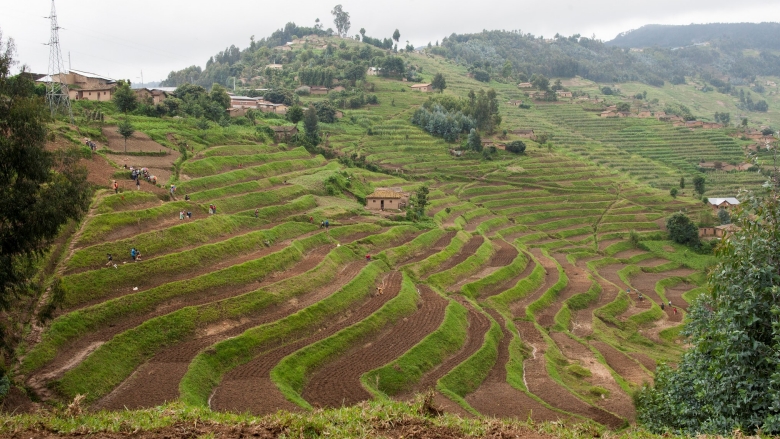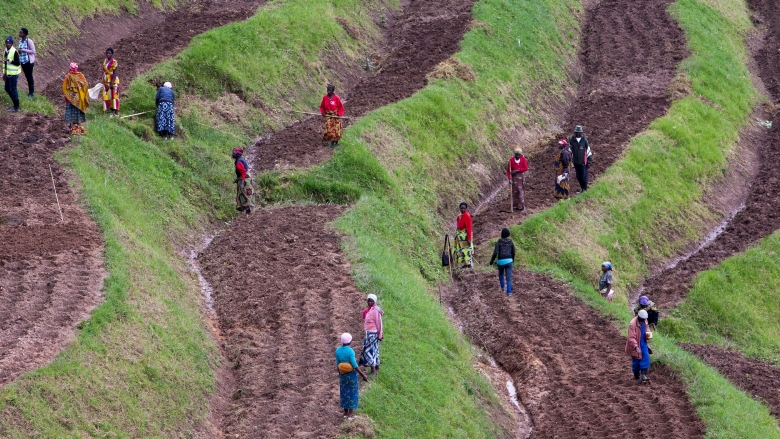Challenge
Rwanda’s growth and poverty reduction agendas depend critically on improving agricultural productivity, which occupies 80% of the work force. 90% of Rwanda’s arable land is found on hillsides. The agriculture sector faces binding land constraints and was additionally characterized by small average land holdings (<0.5ha), poor water management, poor public and private capacity, limited commercial orientation and limited access to output and financial markets. Intensification in the context of steep and challenging physical requirements makes land husbandry a strict necessity and environmental prerogative to avoid the annual erosion of 1.4m tons of fertile soil. Additionally, irrigation is critical to reducing the sector’s chief vulnerability in the climate context: drought and increasingly erratic precipitation.
Approach
The Land Husbandry, Water Harvesting and Hillside Irrigation (LWH) project has been designed to support the Rwandan government (GoR) to address the critical agenda of hillside intensification through improved land-husbandry and increased productivity in 101 pilot watersheds covering 30,250 ha of land. The LWH project funded several LWH sites in support of the GoR program and has been additionally supporting the formulation of a Common Framework of Engagement (CFE) for investments. Following the integrative approach distinguishing climate-smart agriculture, the LWH project combines participatory land-use processes and a modified watershed approach to promote high stakeholder involvement and buy-in. This allowed to build the necessary capacity and infrastructure at an institutional and community level to introduce sustainable land husbandry measures for hillside agriculture, as well as to develop hillside irrigation, ultimately increasing productivity and livelihoods and reducing climate vulnerability.
Results
The LWH project has improved the productivity and commercialization of hillside agriculture, strengthened value chains for agricultural products and expanded access to rural finance, while improving hillside land husbandry technologies, techniques, and infrastructure between 2009 and 2017:
- The project developed 20,601 ha cumulatively with land-husbandry technologies, more than the targeted 19,940 ha.
- The productivity of target irrigated command area ($/ha) increased from 492 to 5,143, versus the target of 2,800.
- The productivity of target non-irrigated command area ($/ha) increased from 469 to 2,571 versus the target of 2,500.
- The share of commercialized products from target areas (%) increased from 35% to 79.84%, compared with targeted 70%.
- The number of direct Project beneficiaries has grown to 292,732 (of which 150,596 are women), which is higher than the end of project target of 120,000 and 55,000 respectively.
- The proportion of beneficiary farmers in project affected areas using improved farm methods (disaggregated by gender) increased from 30% to 93% for men and from 25% to 89.5% for women.
- The percentage of adult project beneficiaries in the project areas who have access to services of formal financial institutions (disaggregated by gender) increased from 22% to 92.3% for men and from 18% to 89.1% for women, versus respective targets of 90% and 85%.
- The proportion of land protected against soil erosion in project areas (ongoing assessment each year) increased from 26% to 103%, exceeding the target of 90%.
- Sediment yield (volume or weight per unit area of catchment (T/ha/yr) in the project areas was reduced by 76%, substantially more than the targeted 50% reduction.
As such, the LHW project substantially increased food security and the climate resilience of the target populations.
Bank Group Contribution
The Land Husbandry, Water Harvesting and Hillside Irrigation project had a total donor budget of $140 million, of which $69 million came from IDA credits, $3.7 million co-financing from the United States Agency for International Development (USAID),$7.8 million co-financing from Canadian International Development Agency (CIDA) and $50 million co-financing from Global Agriculture and Food Security Program (GAFSP), consisting of 11 public and private donors). To date 97% of funds have been disbursed.
Partners
Partnership arrangements for the LWH project came in the form of: (i) programmatic partnership through the LWH CFE; (ii) co-financing for the IDA-financed project with CIDA, USAID and GAFSP (see above); (c) technical partnership with the IFC on leasing; and (d) linkages with rural infrastructure and finance operations outside the project. With its environmental and social safeguards management framework, the World Bank Group has a strong stewardship and catalyst role for parallel and co-financiers that could not be met through other sources of funding.
Moving Forward
The lessons learned from the LHW project will transpire into and scale up the Government of Rwanda’s LHW program, particularly through strengthening of institutional capacities and sector wide approaches. Agricultural productivity and commercialization in difficult topographies will remain a challenge both in Rwanda, the Africa region and beyond, especially in the face of increased climate variability. The LHW project is another proof-of-concept of climate smart agriculture to achieve significant results even in the most challenging environments. The LHW project will inform new projects of the WBG and its development partners will address those challenges in the context of future IDA-financed agriculture projects.
Beneficiaries
Nayirabarinze in Rwamagana District had his life significantly improved by the LWH project. “I used to harvest about 200 kg of maize on one hectare of land.” After implementing land husbandry technologies, his production soared. “In 2014 I harvested 11 tons of maize from two hectares.” By selling his excess produce, Nayirabarinze ventured into poultry farming and now owns 2,800 chicken layers, supplying about 1,000 eggs to markets in Kigali daily. “I earn Rwf70,000 daily from egg sales and this enables me to expand my business. I am planning to have a savings account for my children so that they can live a better life in future.”

